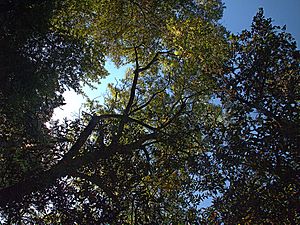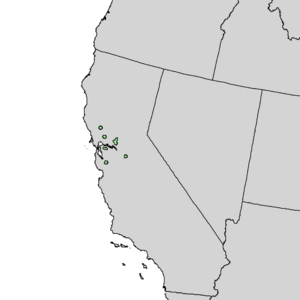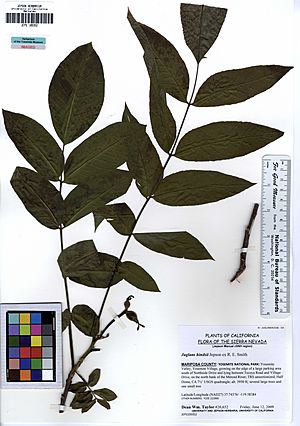Northern California black walnut facts for kids
Quick facts for kids Northern California black walnut |
|
|---|---|
 |
|
| Conservation status | |
| Scientific classification | |
| Genus: |
Juglans
|
| Species: |
hindsii
|
 |
|
| Natural range of Juglans hindsii | |
The Northern California walnut (Juglans hindsii) is a special type of walnut tree. It is also known as Hinds' black walnut. This tree grows naturally only in Northern California. People in the wood industry often call its wood claro walnut. It is also important because it is used as a base for growing other walnut trees.
Contents
Where the Northern California Walnut Grows
The Northern California walnut tree naturally grows in Northern California. You can find it in the San Joaquin Valley and Sacramento Valley. It also grows in the Inner Northern California Coast Ranges and the San Francisco Bay Area.
These trees like to grow near rivers and streams. They can grow by themselves or with other trees. You might see them mixed with California oak trees or Fremont cottonwood trees.
Protecting the Northern California Walnut
Sadly, there is only one natural group of Juglans hindsii trees left. Because of this, the California Native Plant Society lists it as "Seriously Endangered." The IUCN says it is a Vulnerable species. This means it is at risk of disappearing.
The tree is in danger for a few reasons. It can mix with orchard trees, which changes its natural type. Also, cities are growing, and land is being used for farming. This means less natural space for these special trees.
What the Northern California Walnut Looks Like

The Northern California walnut is a medium-sized tree. It often looks bulky and strong. It can grow from 30 to 60 feet (9 to 18 meters) tall. The tree usually has one straight trunk. This trunk can be 10 to 40 feet (3 to 12 meters) tall before branches start.
The top part of the tree, called the crown, can be wider than the tree is tall. The trunks can grow very thick. They often reach 5 to 6 feet (1.5 to 1.8 meters) across near the bottom.
Leaves and Nuts
The leaves of the Northern California walnut are about 1 foot (0.3 meters) long. Each leaf has 13 to 21 smaller leaflets. These leaflets are 2 to 5 inches (5 to 13 cm) long. Their edges are slightly toothed. A special way to tell them apart is by the small tufts of hair. These hairs are found where the veins meet on the leaves.
The nuts of this tree have a smooth, brown, and thick shell. Inside, there is a small nutmeat that you can eat.
Allergies from the Walnut Tree
The Hinds' Walnut (Juglans hindsii) can cause severe allergies. This means some people can have a strong reaction to its pollen. The tree releases its pollen in the spring. The exact time depends on where the tree is located and how high up it grows.
How People Use the Northern California Walnut
Growing the Trees
Juglans hindsii is very important for growing other walnut trees. It is used as a rootstock. This means it forms the strong root base for Juglans regia (English walnut) trees. These English walnut trees are grown in orchards all over the world.
The Northern California walnut is also a parent to a special hybrid rootstock. This fast-growing rootstock is called "Paradox." It is a mix of Juglans hindsii and Juglans regia.
Walnuts as Garden Plants
Special plant nurseries grow the Northern California walnut. These nurseries focus on California native plants. People use these trees in their gardens. They are great for traditional gardens or wildlife gardens. They also fit well in natural landscaping projects.
Because they can handle dry weather, they are good for drought tolerant gardens. These trees are also planted to help bring back natural habitats.
Pests that Affect Walnuts
The Northern California walnut can get pests. One common pest is the Rhagoletis juglandis. This insect is also known as the walnut husk fly. It lays its eggs inside the husks of walnut fruits.
This fly can also infest other types of walnut trees. These include the English or Persian walnut (Juglans regia). It also affects Juglans rupestris, which is a walnut from Arizona and Texas.
Walnut Wood for Lumber
The wood from Juglans hindsii is called claro walnut by people who work with wood. This wood is very beautiful. It has a rich brown color and amazing grain patterns. These patterns are especially striking where large branches meet the trunk.
Claro walnut is used to make special items. It is used for fine furniture and parts of guns. It is also sold as large slabs. These slabs are used to make big tables with natural edges. People like it because it is strong and easy to work with. It also has a swirling, shiny look.
Sometimes, there is a bit of confusion about claro walnut. This is because Juglans hindsii is often used as the rootstock for orchard trees. The wood below where the two trees are joined is claro walnut. The wood above this point is the lighter-colored English walnut. Some woodworkers use this color change as a special design in their pieces.
How the Walnut is Classified
Scientists currently classify the Northern California walnut as its own distinct species. However, some botanists used to think it was a type of Juglans californica (Southern California black walnut). They called it Juglans californica subsp. hindsii. This classification was used in the 1993 edition of "The Jepson Manual."


